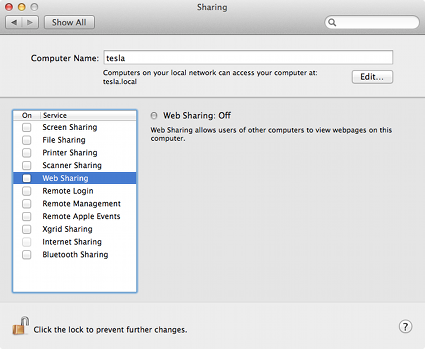

If you want to run Perl scripts, you will have to do something similar:Įnable Perl by uncommenting line 187, changing: Then type ':w!' to save, or just 'ZZ' to save and quit. Then just press 'x' over the '#' character to delete it. (If you aren't familiar with vi, go to line 186 by typing "186G" (without the quotes). LoadModule php7_module libexec/apache2/libphp7.so #LoadModule php7_module libexec/apache2/libphp7.so To get started, edit the Apache configuration file as root:Įnable PHP by uncommenting line 186, changing: Lines in bold courier should be typed at the Terminal.Replace with your short user name. Lines in bold are what you will have to type in. Optional: Xcode is required for adding PHP modules.
#Mac os x apache server root how to

Server does a few specific tricks really well and is a good choice for those. Another note: These instructions apply to the client versions of OS X, not Server. There have been significant changes since earlier versions of macOS. Note: This user tip is specific to macOS 10.15 “Catalina”. I have another User Tip for installing and configuring MySQL and email servers. This User Tip only contains instructions for configuring the Apache server, PHP module, and Perl module. This is meant to be a development platform so that you can build and test your sites locally, then deploy to an internet server. conf file? Please be specific, as I'm relatively new to working with the terminal.Here is my definitive guide to getting a local web server running on macOS 10.15 “Catalina”. If so, what do I need to do other than change the first two lines from the snippet of my. Is it possible to set the document root to a folder that is associated with a specific user - me, in this case? I'm the only user of my machine, and it would be much easier for me to do what I need to if Apache was pointed at that folder. conf file, but this doesn't work - I get the 403 forbidden error - and I'm not sure what to do after that. I know that the first step is to replace the DocumentRoot and Directory in the. I would like to change the DocumentRoot to the folder where I generally keep my web development work, which is: /Users/myname/Desktop/Stuff/Development # Controls who can get stuff from this server. # AllowOverride FileInfo AuthConfig Limit # It can be "All", "None", or any combination of the keywords: # AllowOverride controls what directives may be placed in. # The Options directive is both complicated and important. # Note that "MultiViews" must be named *explicitly* - "Options All"

# Indexes Includes FollowSymLinks SymLinksifOwnerMatch ExecCGI MultiViews # Possible values for the Options directive are "None", "All", DocumentRoot "/Library/WebServer/Documents" However, I'm not sure I fully understand how to do this, or if it is even possible to set it up the way that I would like to.įor starters, here's the snippet from my nf file (I haven't made any changes, this is stock).
#Mac os x apache server root mac
I'm just getting started using Apache on my Mac (El Capitan 10.11.13), but I'd like to change the document root.


 0 kommentar(er)
0 kommentar(er)
